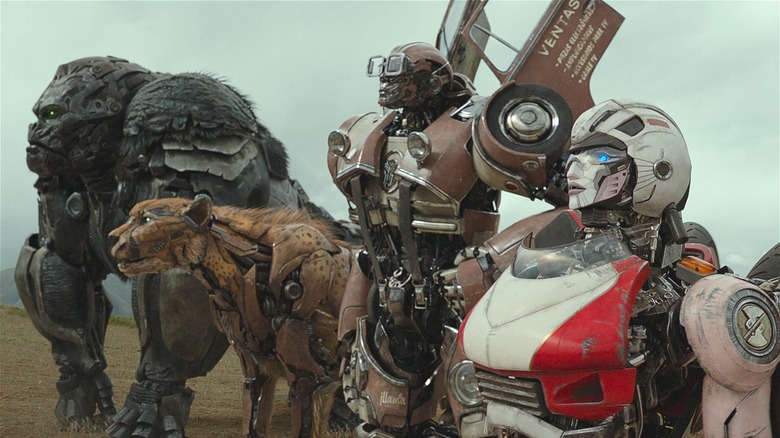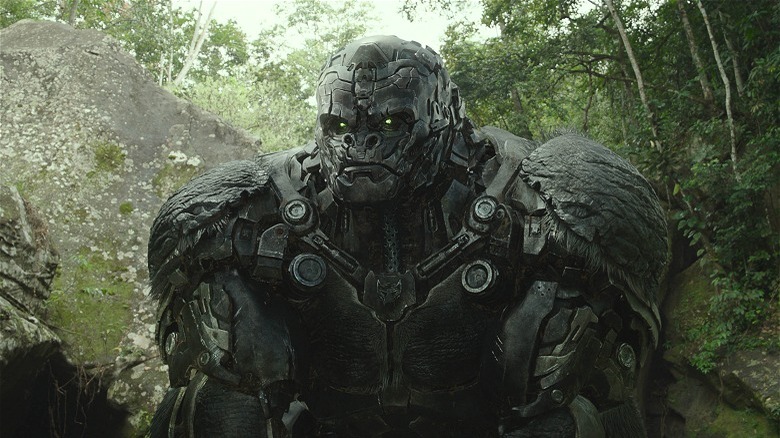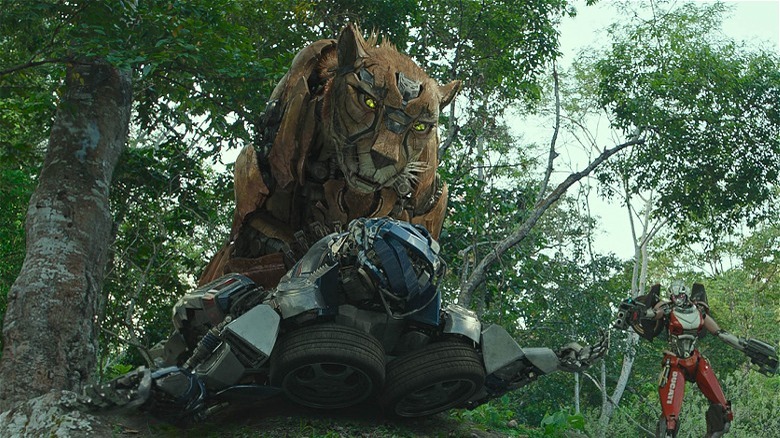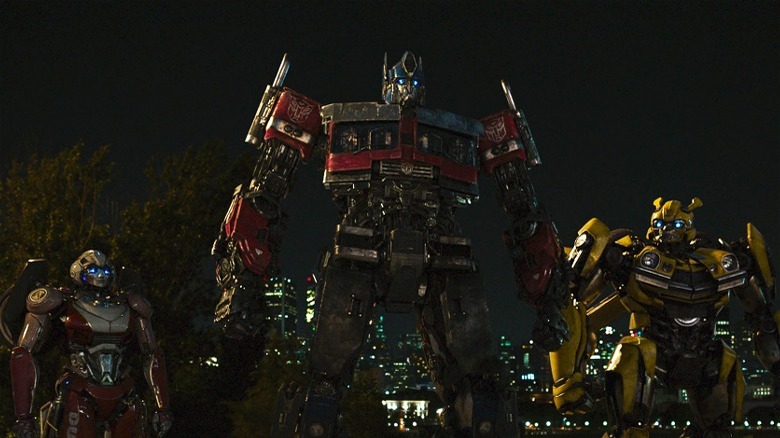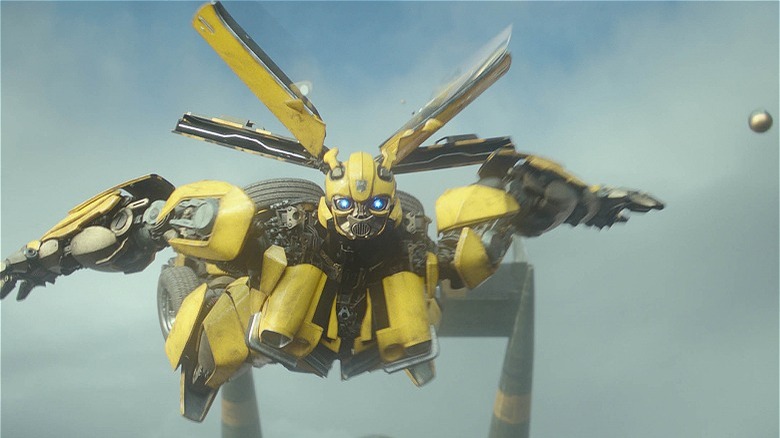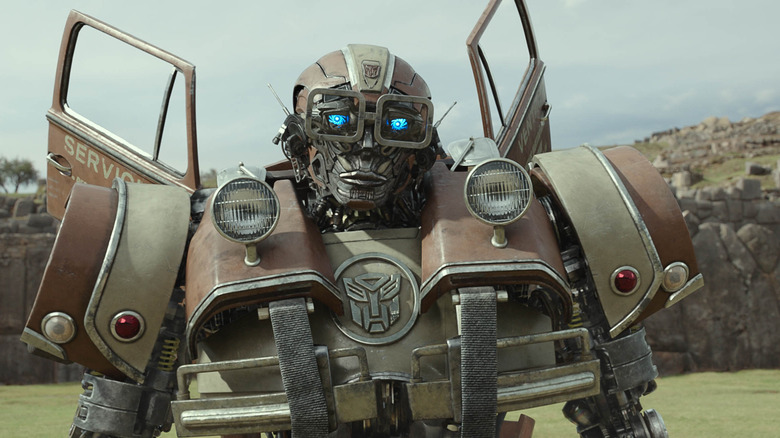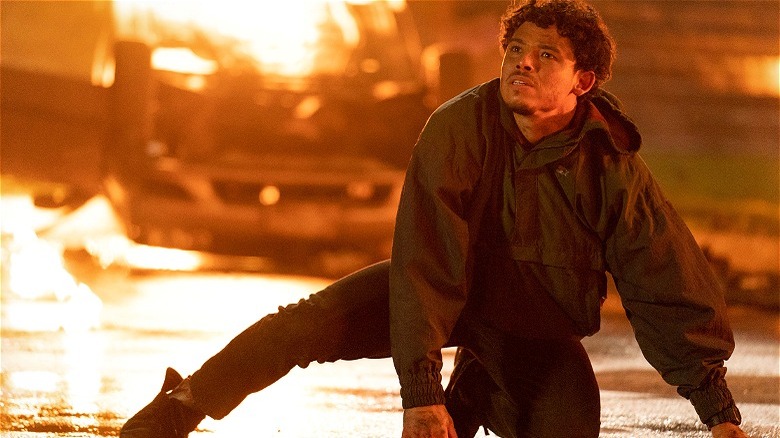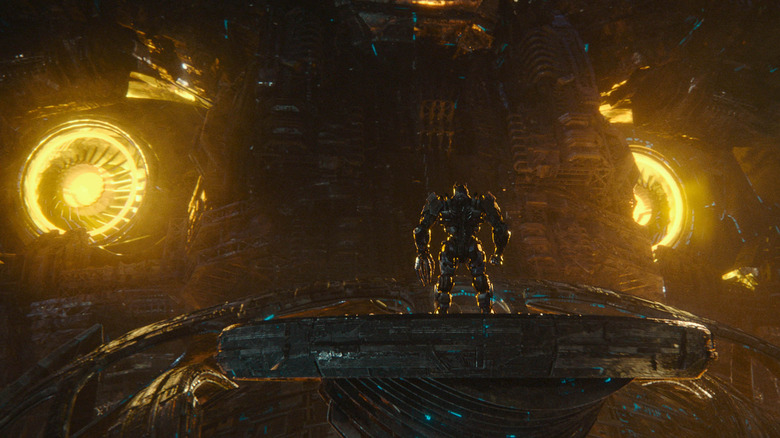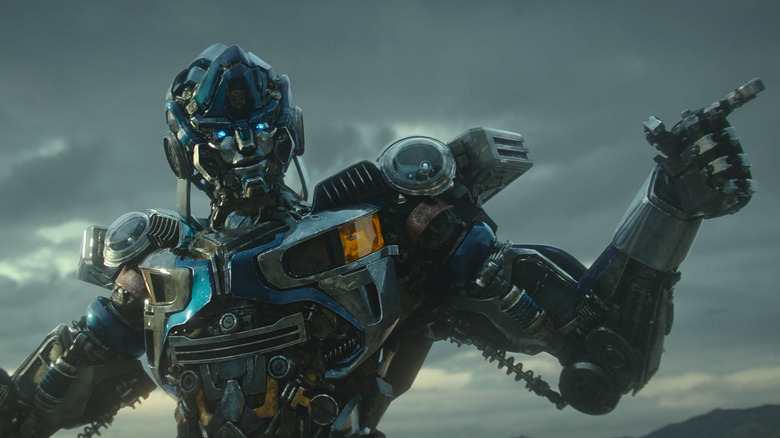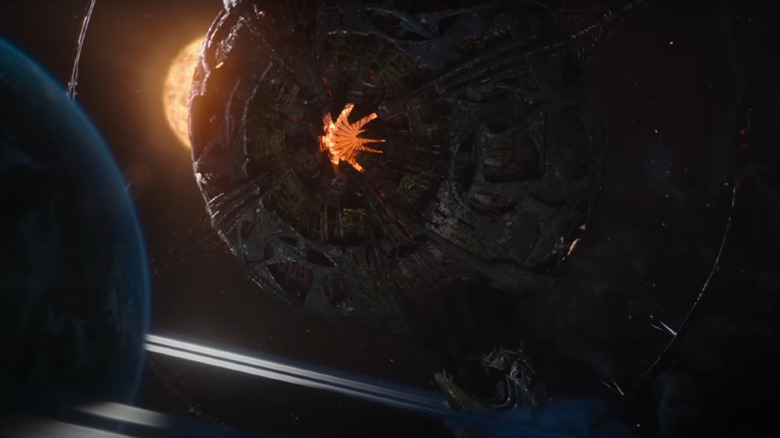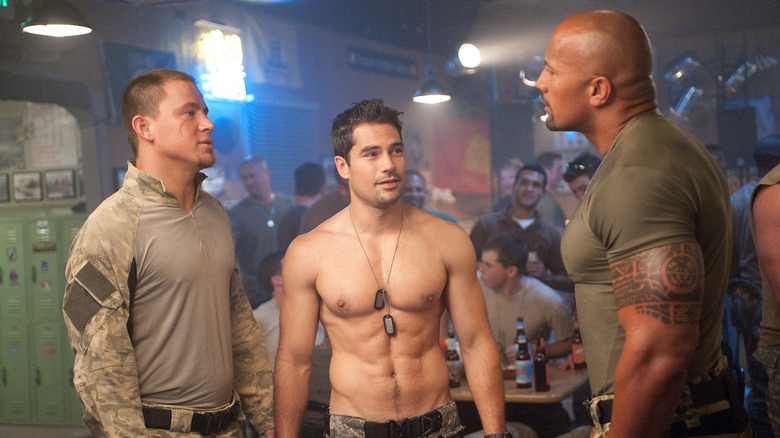10 Things About Transformers: Rise Of The Beasts That Make No Sense
The following post contains spoilers for "Transformers: Rise of the Beasts."
A "Transformers" movie that doesn't make sense? The hell you say!
Look, it's true that the film franchise as a whole is, to quote the voice of Sentinel Prime (Leonard Nimoy), highly illogical. Even those of us who love these movies will admit that their continuity constantly rewrites itself, their internal logic is shaky, and nobody producing these movies seems to care. For fans of the toys who see this as a bug, it's eternally irritating. For Michael Bay fans, it's a feature — the absurdity is one more reason to like them, rather than a strike against.
However, Bay's invent-the-story-as-it-goes-along logic is one thing, but since he left, the attempt to crank out prequels that still somehow fit the same continuity has left some Constructicon-sized holes. Bay never worried much if the stories of successive movies matched, but the teams behind "Bumblebee" and "Rise of the Beasts" really appear like they're trying. They could have just declared their movies reboots, and it wouldn't matter, but details like avoiding the use of Megatron because he should be frozen in ice at the time indicate they're attempting to fit in. Perhaps because they try so hard, it's easier to see the things that make no sense, either on their own terms or in the context of other movies.
What exactly are we talking about? Let's break it down. Be forewarned that there are major spoilers involved.
10. Why do the Maximals look like that?
The Maximals, robotic animals that can "maximize" into more humanoid forms for battle, initially live on what looks to be a peaceful jungle planet, far across space and apparently time. Why, then, does their appearance approximate the animals of Earth, a place they've never been to before?
Optimus Primal says he was named after Optimus Prime, which indicates that his initial timeline is in our future. So, the best guess is that if whoever named him knew about Optimus Prime and knew about Earth, that planet Optimus was so fond of defending. And from there, they found out about gorillas, and probably read "Spawn" comics featuring Todd McFarlane's Cy-Gor. Unlike a lot of other Transformers, Primal couldn't have scanned anything to achieve that alternate form, unless there actually was a race of robo-gorillas on that planet already. We presume Apelinq, the other robo-gorilla seen, is also a Maximal, but hey, maybe he's just a native creature that Optimus Primal did scan.
It seems unlikely Primal's creators scanned Earth's database too hard, though, or they'd have learned about King Kong. And given Decepticons' predilection for turning into airplanes, well, that's something to avoid.
And don't say, "It's explained in the cartoon." The "Transformers" movies have quite literally pissed on cartoon continuity. But there's still another question that arises ...
9. Robots in disguise?
Transformers are robots in disguise. It's their ad slogan, and the first line of their theme song. So what, exactly, are the Maximals "disguised" as?
The "Beast Wars" cartoons used now-primitive CG, and the toys were toys, but there was plausible deniability that, in animal mode, the Maximals resembled actual animals. Not here, they don't. They have realistic fur, but robot faces. Perhaps that works on a planet where everything is like that. But when we meet them, they've literally been on Earth for more than 1,000 years. Do they not have the ability to scan something else, and blend in?
We can grant them a few centuries of being worshipped as gods, as seen in antique art. And maybe the Peruvian jungle is just so dense they always manage to hide in it. Airazor, though, was in the Middle East. Nobody ever had an issue with Robo-Eagle? She never thought being a hippo or camel might be less conspicuous? If this is in canon with "Revenge of the Fallen," Airazor also completely missed the giant pyramid weapon.
More to the point, were humans of the '90s and earlier so stupid they didn't notice? As seen in "Bumblebee," there's literally now a government organization — Sector 7 — specifically looking for Transformers. Two, if you count G.I. Joe.
8. What's with Grumpy Prime?
Optimus Prime is a hero. John Wayne inspired his voice. He believes freedom is the right of all sentient beings, and says so ... a lot. So what's with him being a human hater in "Rise of the Beasts"?
Sure, Bay fans were cool with Optimus violently killing other robots and being a jerk sometimes, but they also made clear it was due to PTSD trauma. This Optimus may have Cybertronian war PTSD, but his only major encounter with humans was when he saw his buddy Bumblebee befriend Hailee Steinfeld. Doesn't he trust Bumblebee? Wouldn't Bumblebee have told him they took out a pair of Decepticons together?
It takes seeing Miguel bond with Mirage before Optimus gets it. He's that sort of jerky friend who never believes you but always must see it for himself. And considering robot databanks allow for perfect recall and recordings, that's an especially jerky trait for an Autobot.
7. Bumblebee's death and rebirth
"Rise of the Beasts" aims to shock when it lets arch-villain Scourge kill Bumblebee. Except that since this is a prequel to five other movies that all star Bumblebee, it's ridiculous to think that. He has plot armor that Mirage doesn't. Fortunately, his method of death is entirely reversible if he can get around some charged-up Energon, which, conveniently, happens every time Unicron gets close to a planet he's about to eat. That's something Scourge should realize, because he's there every single time it happens.
So, Scourge used a means of killing that he knows on some level is not only reversible but imminently will be reversed. Unless he's self-sabotaging, he shouldn't be that stupid. He ought to go full zombie-fighting mode, either blowing Bumblebee's head clean off or doing "Evil Dead"-style dismemberment. That said, as revealed in other "Transformers" movies, even dismemberment doesn't keep Bumblebee down. The plot armor is strong with this one.
6. Why do robot eyes need protecting or enhancing?
Transformers get a lot of leeway in terms of appearance, just as they do in how they talk, because to some degree, they're mirroring human behavior. No logical reason exists for them to sport beards, or even sculpted hair at all, or for that matter, articulated mouths. (Do Autobots have beards when they're first created, i.e., as kids? Or do they add them later?) Still — glasses and goggles? Are their Autobot eyes failing, or in need of protection?
Stratosphere has the goggles-up look in robot mode to mirror the sort of RAF pilot he talks like. (Let's leave aside the very first movie's claim that they learn English from the World Wide Web, which was barely a thing in the early '90s, and certainly not a thing during the '80s setting of "Bumblebee.") But Stratosphere doesn't need eye protection to fly because he turns into a plane, and his head goes .. who knows where.
As for Wheeljack, his glasses actually do provide functions — but why can't they be built into his robot eyes? Maybe he just wants to model Steve Urkel, with his matching nerd suspenders, also a thing robots don't need. If he learned human behavior from "Family Matters," though, he got the voice way wrong, and can't even use the excuse that he was watching the dubbed version, since he speaks not Spanish, but heavily accented English as his first language.
5. Was that generator just in the ground the whole time?
Unicron shows up, and a giant alien generator just bursts out of the ground, from deep enough in the Earth that there's lava. Was that there the whole time, or did Scourge somehow summon it from nothing? If the former, you'd think the Maximals might have figured that out over 1,000 years or so and taken care of it.
Oh, but they can't destroy it, because that would create the equivalent of a nuclear blast if they did. So instead, they devise an elaborate plan to sabotage the thing, and that doesn't work, so they go ahead and destroy it anyway. Fortunately, Optimus Primal overestimated the force of the explosion by, like, a lot. Here's a hint — if a nuclear bomb is about to go off, driving away from it even at full speed will not save your ass. Besides that, in the winds generated by such an incident, holding somebody's hand, even if it's a robot's, won't keep you from being blown away either.
4. Wait ... Isn't Unicron supposed to be Earth?
"Transformers: The Last Knight" led up to the big reveal that in Transformers lore, the name of Earth is Unicron. His horns emerged from the surface of the planet, and as Quintessa (Gemma Chan) told people in the credits scene, "He doesn't like to be touched." It's one hell of a cliffhanger to reveal that we all live on a yellow Decepticon, a yellow Decepticon, a yellow Decepticon ...
Now, apparently, we don't. Unicron is a completely separate entity that wants Earth for food. Earth, however, exists in its past, based on what the Maximals tell us about their timeline. So, Unicron is pretty seriously unaware of the butterfly effect here. Because if all the movies are in continuity, Unicron is Earth in the future, after it presumably busts free of all that pesky dirt and humans living on top of it. And he's come back through time to ... eat himself?
Even if it's a separate Unicron — multiple Transformers share names, like the movies having two different Devastators — eating Earth in the past could seriously alter the future. If Optimus Prime dies there, a whole lot of Transformers lore will change, and all the Michael Bay movies will be erased from continuity. Hey, maybe Unicron's a film critic!
3. Mirage breaks the mass-shifting rule
One hard and fast rule the Transformers themselves have observed in movie form since the beginning is no mass shifting. Every transformation has to actually be one that could work, so a kaiju-sized Megatron can't shrink down to become a handgun, like in the cartoon; a complication borne from the fact that the first Transformers toys were repacks of multiple different scales of transforming toys from Japan. A boombox that transforms will stay as small as Frenzy in robot mode. The only exception is the Allspark cube, which is magic.
Mirage massively violates this rule at the end of "Rise of the Beasts," when he becomes wearable armor for Noah (Anthony Ramos). The only way that remotely works is if he somehow repacked his molecules so densely that his matter compressed, but then Noah would be wearing the weight of a car on himself, and be unable to move. Mirage could have become a much larger mech with Noah piloting, and the plot point would still have worked, but it looks like director Steven Caple Jr. really wanted his own Iron Man.
If Mirage was so comatose at the time as to appear dead, how could Noah have then unpacked those newly dense molecules to repair him in car form?
2. Scale in general
It's best not to even think about some other questions of scale. Unicron is planet-sized. If he has a face, and we know he does, because he's a Transformer, his eyes would be so huge and so far apart that Scourge would not realistically be able to have a face-to-face conversation with him. Unicron's face, if he were Earth, would be the size of Australia.
From the surface of the planet, it looks like he rips a tiny hole in space-time over Peru. It's one that's manageable enough for the Autobots to close. Why, though, when he unleashes his bot-swarm, does it cover New York City? Just so some cheap, unearned 9-11 imagery can get sandwiched in? They maybe should have run that by Mirage voice actor Pete Davidson, whose father died that day. Sure, from space, it looks like Unicron's ripping a bigger hole — one that, by the way, would also throw off Earth's gravity and rotation by a substantial margin. Plotwise, though, it seems clear there was just the one hole, and those robots managed a flight that would normally take a couple of hours in seconds, just to inconvenience the Big Apple.
1. G.I. Joe searches for alien threats now?
Most fans of the Transformers movies probably figured that that end scene was going to have Noah recruited into NEST, the special military force that assisted the Autobots in previous installments. Instead, it baits and switches in a way some fans always hoped it would. NEST was sort of a thinly veiled G.I. Joe anyway, and now "Rise of the Beasts" makes it official that G.I. Joe is an organization dedicated to seeking out extraordinary threats like aliens.
Wait, what? G.I. Joe, at least in its current iteration that began in the '80s, is an elite division of the U.S. military designed to fight Cobra, a terrorist organization for whom apparently money is no object, using its science-fiction-level army to try to rule the world. G.I. Joe in this version did canonically fight aliens at one point, but the less said about the Lunartix Empire ("Lunartix," get it?) the better.
Thankfully it can't be the same G.I. Joe from the "Snake Eyes" movie, which is just getting started in our time period. It could be the one from the Channing Tatum films, which existed before they recruited his character, in which case Cobra isn't formed yet. If successive movies go there, however, it leaves a lot of key characters off the table. What does this mean for NEST, though? And where was Joe all those times Megatron attacked?
